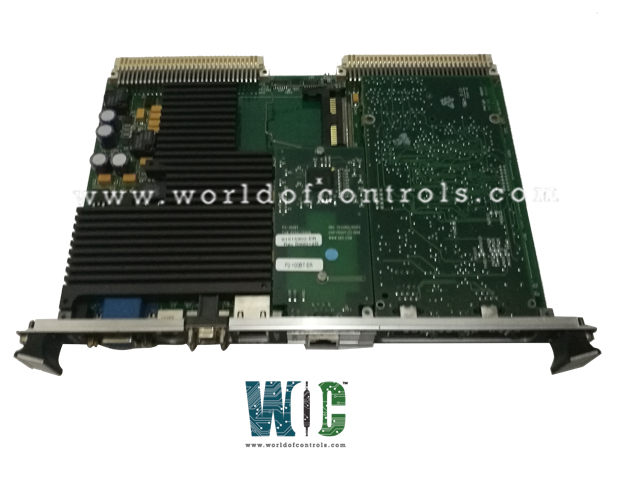SPECIFICATIONS
Part No.: IS215UCVEM04A
Manufacturer: General Electric
Country of Manufacture: United States of America (USA)
PROFIBUS Interface: PROFIBUS DP master class 1
Temperature Operating: -30 to 65 o C
Microprocessor: Intel Celeron 300 MHz
Operating System: QNX
Product Type: Single-slot Board
Availability: In Stock
Series: Mark VI
Functional Description
IS215UCVEM04A is a Single-slot Board developed by GE. It is part of Mark VI control system. UCVEM04A serves as the standard controller within the Mark VI system, offering robust performance and versatile connectivity options. This single-slot board is equipped with a 300 MHz Intel Celeron processor, providing ample processing power for control and monitoring tasks. It is available with either 16 or 128 MB of flash memory and 32 MB of DRAM, ensuring sufficient storage and memory capacity to accommodate various application requirements.
Hardware Specifications
- Processor: Equipped with a 300 MHz Intel Celeron processor, which provides the necessary computational power to handle the demanding control and monitoring tasks required in industrial environments. The Intel Celeron is a cost-effective processor that balances performance with efficiency, making it ideal for real-time control systems. Its primary role is to execute control algorithms, manage data, and ensure communication between different components in the Mark VI system. This processing capability ensures smooth and reliable operations in applications like gas and steam turbine control.
- Memory: The module offers flexible memory options, including 16 MB or 128 MB of flash memory and 32 MB of DRAM. The flash memory serves as non-volatile storage, retaining important data such as firmware, configuration files, and system data even when power is lost. The 16 MB option is suitable for systems with lower data requirements, while the 128 MB option accommodates more complex operations and data storage needs, such as extensive logging or larger firmware updates. The 32 MB of DRAM provides fast access to temporary data and ensures efficient real-time processing of inputs, control logic, and outputs. This combination of memory options makes it adaptable to various industrial scenarios, from basic to more memory-intensive applications.
- Ethernet Connectivity: For network connectivity, the board includes a 10BaseT/100BaseTX Ethernet port, which is compatible with both 10 Mbps and 100 Mbps network speeds. This Ethernet port, equipped with an RJ-45 connector, enables the board to connect seamlessly to the Universal Display Hub (UDH), facilitating real-time communication between the controller and other system components, including human-machine interfaces (HMIs) and diagnostic tools. Ethernet connectivity supports rapid data transfer, ensuring the entire system operates in sync, even in complex industrial environments where high-speed communication is critical.
- Additional Ports: In addition to its standard Ethernet capabilities, supports additional Ethernet ports and Profibus connectivity, further enhancing its communication capabilities. The availability of multiple Ethernet connections allows the board to manage more complex network setups, supporting a wide range of devices and ensuring efficient data flow across the system. The integration of Profibus adds another layer of versatility, allowing the controller to communicate with field devices such as sensors and actuators, which is especially useful in distributed control systems where a large number of devices need to be connected and managed simultaneously.
Secondary Ethernet Ports
- Secondary Port Support: Supports secondary 10BaseT/100BaseTX Ethernet ports for use on a separate IP logical subnet.
- Configuration: Configuration of secondary Ethernet ports is performed through the toolbox interface.
- Validation Mechanism: Ensures coherence and alignment of toolbox configuration with existing hardware setup during power cycles.
Features
- Validation Process: Critical checkpoint to ensure toolbox settings accurately match hardware configuration.
- Enhanced Connectivity: Empowers users with versatile connectivity options for system integration.
- Reliable Operation: Facilitates proper synchronization and functionality of secondary Ethernet ports upon system power-up.
LEDs
- Top LED: Active
- Blinking: Indicates active communication or data transmission over the Ethernet connection.
- Solid: Implies that there is no activity or data transmission occurring over the Ethernet connection, signifying an inactive state.
- Bottom LED: Link
- Yellow Light: Indicates a 10BaseT Ethernet connection, suggesting that the network operates at a maximum speed of 10 Mbps.
- Green Light: Represents a 100BaseTX Ethernet connection, signaling that the network operates at a faster speed of 100 Mbps.
Memory configuration
- 32 MB DRAM (Dynamic Random Access Memory):
- Provides volatile memory for storing data and program instructions that the processor can access quickly during operation.
16 or 128 MB Compact Flash Module:
- Offers non-volatile storage for the system's firmware, operating system, and application programs.
- The Compact Flash Module provides reliable and compact storage for essential system software components.
- 128 KB L2 Cache (Level 2 Cache):
- Acts as a high-speed buffer between the processor and main memory (DRAM), enhancing system performance by storing frequently accessed data and instructions for quick retrieval.
- Battery-backed SRAM (Static Random Access Memory):
- Includes 8 KB of memory, allocated as Non-Volatile RAM (NVRAM) specifically for controller functions.
- The battery backup ensures that data stored in SRAM remains intact even during power loss or system shutdown, providing critical data persistence for essential controller operations.
The WOC team is always available to help you with your Mark VI requirements. For more information, please contact WOC.
Frequently Asked Questions
What is IS215UCVEM04A?
It is a single-slot board developed by GE under the Mark VI series.
What are secondary Ethernet ports on modules used for?
Secondary Ethernet ports on some modules are utilized for connecting to a separate IP logical subnet, enabling distinct network configurations.
How is the configuration of secondary Ethernet ports performed?
The configuration of secondary Ethernet ports is carried out through the toolbox interface provided by the module.
How does the module ensure the accuracy of its configuration settings?
The module validates its toolbox configuration against the existing hardware setup every time the rack is powered up, ensuring alignment and coherence.
